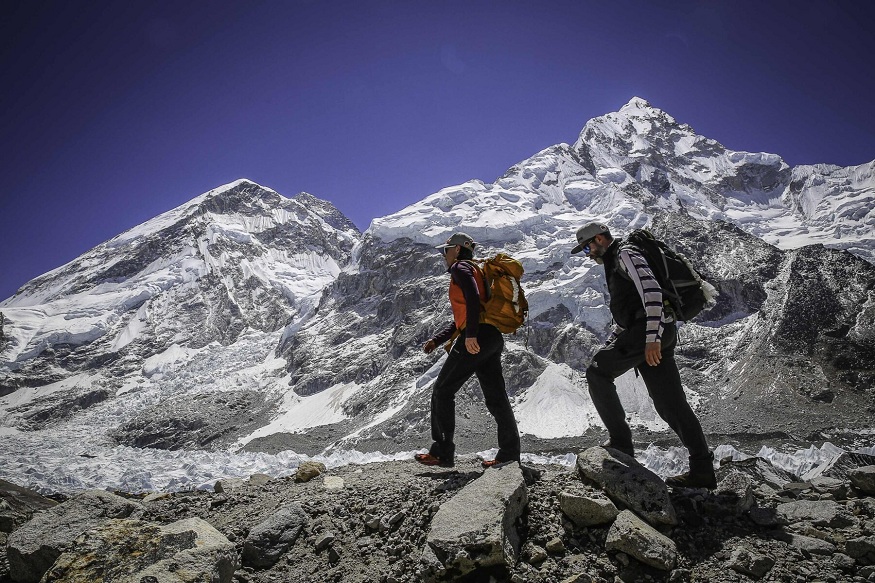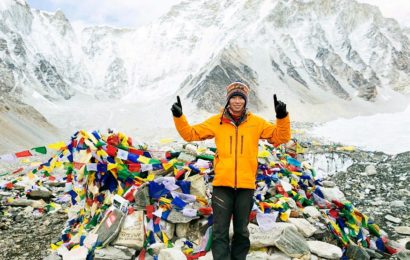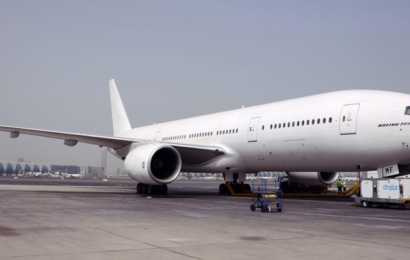 When most people think of trekking in Nepal, they think of the trek to Everest Base Camp (EBC) — an iconic journey that starts in the bustling capital of Kathmandu. Trek to EBC is a bucket-list experience for many trekkers from around the world, thanks to its breathtaking landscapes and spiritual significance. To give you an idea, the journey can be split into two sections — flying to Lukla and trekking from Jiri overland. The most commonly taken option for the majority is to take a flight from Kathmandu to Lukla, the gateway to the Everest region. There is also an adventurous, if you’re lucky to get the seat next to the window, 30-40 minute flight that can take you right next to the Himalaya peaks, including Mount Everest! The trek to Everest Base Camp starts at Lukla’s Tenzing-Hillary Airport and follows a well-beaten path through Sherpa villages, forests, and rugged high-altitude terrain. The journey takes you through places like Phakding, Namche Bazaar, and Tengboche before getting to Everest Base Camp, which lies at a height of 5,364 meters.
When most people think of trekking in Nepal, they think of the trek to Everest Base Camp (EBC) — an iconic journey that starts in the bustling capital of Kathmandu. Trek to EBC is a bucket-list experience for many trekkers from around the world, thanks to its breathtaking landscapes and spiritual significance. To give you an idea, the journey can be split into two sections — flying to Lukla and trekking from Jiri overland. The most commonly taken option for the majority is to take a flight from Kathmandu to Lukla, the gateway to the Everest region. There is also an adventurous, if you’re lucky to get the seat next to the window, 30-40 minute flight that can take you right next to the Himalaya peaks, including Mount Everest! The trek to Everest Base Camp starts at Lukla’s Tenzing-Hillary Airport and follows a well-beaten path through Sherpa villages, forests, and rugged high-altitude terrain. The journey takes you through places like Phakding, Namche Bazaar, and Tengboche before getting to Everest Base Camp, which lies at a height of 5,364 meters.
The fastest and most common route is to fly to Lukla for the Everest Base Camp Trek, but several trekkers choose an overland route to Lukla via Jiri. This route is the longer and, within reason, physically more tiring way, but it allows for more of a slow pace trek that enables trekkers to better acclimate to the altitude while walking through lovely rural villages and catering for a less-populated trail. Valid for Glacier and Forest Trek (Tourist Visa for Kathmandu): For one stop, the overland trek goes from Jiri to Lukla (7 to 10 days). This alternate route allows for a more authentic and untouched glimpse of Nepalese rural life before entering the Everest region.
One of the most important things, regardless of the route taken, is acclimatization on the trek. As trekkers ascend, they need to adapt to the thinning air. Trekkers are advised to take regular rest days and ascend gradually, as altitude sickness can be a risk. Stopping in Namche Bazaar, which sits at about 3,440 meters, in particular offers the chance for acclimatization while giving trekkers a chance to visit local shops, cafes, and cultural sights. Another important stop is at Pheriche, where trekkers can rest up and acclimatise themselves for the last push to base camp. Lukla to EBC trek also involves days of trekking after the last stop – the entire trip generally takes around 12-14 days under normal conditions, including rest days.
When trekkers make it to Everest Base Camp, they’re rewarded with stunning vistas of the towering Khumbu Icefall, as well as nearby summits including Lhotse, Nuptse, and Makalu. From tireless preparation to grueling physical exertion, not to mention the desire underlying every mountain summit, the feeling of standing in front of the highest mountain in the world. In addition to breathtaking natural beauty, the trek provides an opportunity to connect deeply with the culture of the Sherpa people, who have inhabited the area for generations. In summary, hiking to Everest Base Camp is an incredible experience that combines physical challenge, cultural exploration, and breathtaking mountain views.
Chapter 1: What you learn on the trek to Everest base camp
Since the trek to EBC itself is an incredible adventure where trekkers get to see some of the best sights in the world. Sitting in Nepal’s Khumbu region, EBC is the base camp for Mount Everest, the tallest mountain in the world. The two main ways to start the trek to EBC are flying to Lukla & trekking from Jiri. The fastest and most comfortable option to get to the trekking start is, of course, the flight, an option most trekkers choose, while some prefer the longer overland route for the experience. The hike itself, be it from Lukla or Jiri, is full of magnificent scenery, cultural insights, and high altitude acclimatization process. It entails a physically strenuous trek, proper preparation, and acclimatization to reach a base camp of 5364 meters. Either trail provides a very different hiking experience, and which to choose often boils down to personal preference, time availability, and your level of fitness.
Taking a flight from Kathmandu to Lukla
Probably the most comfortable and commonly used way to get to the trailhead for the Everest Base Camp trek is by flying from Kathmandu to Lukla. His flight leaves from Tribhuvan International Airport in Kathmandu, then winds its way through mountains to arrive at Tenzing-Hillary Airport in Lukla 30 to 40 minutes later. Lukla sits at an elevation of 2,860 meters, and though the flight is nothing short of spectacular, the conditions can also be a little frightening, not least because of the short and steep runway at Lukla. But for the great majority of trekkers, the flight is a requisite part of the experience, slashing travel time and making the trek more accessible. After the flight, trekkers are ready to begin the trek to Everest Base Camp, and the first day’s hike usually takes them to Phakding. After that, it passes popular places like Namche Bazaar, Tengboche, and Pheriche and reaches the base camp after 12-14 days.
This option, as the name itself already indicates, also entails a little trekking, however, not from Lukla.
Everest Base Camp Treks For adventure seekers, there’s a longer, more challenging trek from Jiri to Lukla that is even better. This overland route eliminates the need to fly to Lukla and tacks on an additional 7 to 10 days of trekking before arriving at the starting point for the Everest Base Camp trek. The trek from Jiri, a relatively small town located in the east of Nepal, to Lukla is about 150 kilometers through limited villages, leafy woods, and terraced fields. Those who choose to trek out from Jiri to Everest gain a closer view of Nepali village life as a part of the experience. It also enables better acclimatization to the high altitudes, the gradual increase helps in reducing the chances of altitude sickness. But this adds extra days and effort to trek from Jiri, so this option is best suited to experienced trekkers wanting a longer, more physically challenging trek.
How to Get to Lukla: What to Expect
Whether you fly or trek from Jiri, arriving in Lukla is an exhilarating part of the Road to Everest Base Camp. The flight to Lukla, a short one, is a Log Agog for us. While it has breathtaking, panoramic views of the mighty Himalayas, it is renowned for its lethal weather conditions as well as short runways, making it one of the most dangerous airports in the world. During the monsoon and winter seasons, flights are prone to being delayed or canceled due to weather. Expect a 7-10-day trek through the Nepali countryside that includes steep climbs and remote villages if you’re walking the Jiri option. No matter how you arrive in Lukla, it is important to prepare to acclimatize and allow flexibility in your travel plans to account for possible delays.
Lukla to Everest Base Camp Trek: Route/Duration
Mount Everest Base Camp Trek The real trekking action starts after you land in Lukla. It takes a week or more of hiking through charming villages, past Buddhist shrines and monasteries, and across high-altitude terrain to get to Everest Base Camp. The trek usually takes 12-14 days, though this depends on your pace and need for acclimatization. Trekkers usually go to Phakding on the first day, and Namche Bazaar on the second, a key stop for acclimatization. After which the route goes to Thengboche, Pheriche, and Lobuche, the ultimate destination is Everest Base Camp (5,364m). It is perhaps the most popular trek in Nepal, providing breathtaking views of Mount Everest, its neighbouring peaks Lhotse, Nuptse, and others, and also an insightful cultural experience in the Sherpa villages. Proper acclimatization is essential to avoid altitude sickness during the trek, and most trekkers will take additional rest days at key stops. The journey to Everest Base Camp requires physical endurance, but it is arguably one of the most fulfilling experiences for adventurers.
Acclimatization: Why It’s Important on the Trek to EBC
One of the most vital factors to keep in mind when walking the trail to Everest Base Camp (EBC) is the matter of acclimatization. When trekkers climb to higher altitudes, the air is thinner and there’s less oxygen, which can trigger altitude sickness. To prevent this from happening, trekkers must allow their bodies time to adjust to the lower levels of oxygen. Acclimatization consists of gradually increasing altitude, so the body generates extra red blood cells and can get oxygen more easily. The planned trekking itinerary seeks to give trekkers sufficient time to acclimatize, most commonly through passing through Namche Bazaar (3,440 meters), where travelers frequently take rest days, and Pheriche (4,240 meters), where most trekkers do the same to allow the body to adjust. Gradual familiarization is important, and you shouldn’t gain more than 500 meters of elevation a day after you’re over 3,000 meters. Symptoms of altitude sickness include dizziness, nausea, and headaches, and can worsen if untreated. Trekking at a slow pace, with plenty of water and rest on acclimatization days, significantly increases your chances of making it to EBC without serious health complications.
Day-by-Day Trekking Itinerary
Trekking to Everest Base Camp is a minimum of 12-14 days, which includes plenty of time for altitude acclimatisation as well as enjoying the spectacular scenery en route. Here’s how a typical itinerary breaks down:
Day 1: Kathmandu to Lukla – Following an exhilarating flight to Lukla, you’ll trek to Phakding at a lower altitude for a gentle start.
Day 2: Phakding to Namche Bazaar — A 6- to 7-hour trek that climbs steadily through forests and villages, ending in Namche Bazaar, where you will rest and acclimatize.
Day 3: Acclimatization Day at Namche Bazaar – Hike to nearby viewpoints such as Everest View Hotel to help with acclimatization.
The Day 4t: Namche to Tengboche – 5-6 hours trek (via Jorsale) along the Dudh Koshi river. Explore the iconic Tengboche Monastery.
Day 5: Tengboche to Pheriche – 5-6 hour trek via Dingboche and Pheriche, which offers greater acclimatization.
Day 6: Acclimatization Day in Pheriche – A rest day that includes a short hike to allow your body to adjust to the altitude.
Day 7: Trek to Lobuche from Pheriche – Trek for an estimated 5 hours through Thukla and Dughla and further on to Lobuche.
Day 8: Lobuche to Everest Base Camp – A trek through rocky terrain, this 7-8 hour day leads to Everest Base Camp.
Day 9: EBC to Gorak Shep: After visiting EBC, continue on to Gorak Shep, where you’ll be sleeping for the night.
Day 10: Gorak Shep to Kala Patthar and back to Pheriche – Early morning ascent to Kala Patthar, where we catch an amazing sunrise view of Everest before descending to Pheriche.
Day 11-12: Return Trek – Backtrack to Lukla, and fly back to Kathmandu.
Alternate Paths: Gokyo Lakes And Three Passes Trek
Everest Base Camp Gokyo Lakes and Three Passes TreksIf you’re looking for a more adventurous alternate trek to the classic Everest Base Camp route, consider the Gokyo Lakes and Three Passes treks, which will give you an extended, all-encompassing experience. The Gokyo Lakes Trek: The Gokyo Lakes trek leads you through the picturesque Gokyo Valley, where you visit scenic Gokyo Lakes and climb up Gokyo Ri to see panoramic views of Mt. Everest and Cho Oyu peaks. The Three Passes Trek is a strenuous but rewarding trek that crosses three high mountain passes: Kongma La, Cho La, and Renjo La. It gives you amazing views of the whole Everest area, including Makalu, Lhotse , and Nuptse. Both of the alternate routes have fewer people on the trail than the classic EBC route, but are physically strenuous and require great physical conditioning.
Pros and Cons of Traveling with a Guide and Porter
The Everest Base Camp trek guides with porter, Guide Hiring in Everest Base Camp trek, Everest Base Camp trek with guide and porter Guides are not only familiar with the terrain, but they also understand the local culture and safety protocols, and they also help to ensure you’re trekking at a safe pace, especially about altitude acclimatization. Porters, though, will tote your more cumbersome gear, meaning you can hike unencumbered. This can help with your comfort level and stamina significantly. Guides and porters are often additional costs, and some trekkers choose to trek independently so that they can enjoy a sense of self-sufficiency. Those trekking on a budget or looking for more flexibility can also consider going without a guide or porter. But that takes planning and navigation. If you’re a first-timer on the trek or do not know the region, it’s advisable to get both a guide and a porter with you for safety and convenience.
Getting ready for the trek: fitness, gear, and permits
The most important preparation before embarking Everest Base Camp trek. Fitness is also important because the trek means long, rugged days of walking at high altitudes. Begin your training or preparation at least two months ahead of the scheduled date, preparing your cardiovascular endurance, strength, and stamina. Gear is equally important. Have decent layers of clothing, boots, a bag (backpack), and sleeping gear. Don’t leave behind holiday essentials such as a sleeping bag rated for cold temperatures, trekking poles, and a headlamp. Finally, before you head out, be sure you have all the necessary permits. This usually consists of a TIMS (Trekking Information Management System) card and a Sagarmatha National Park entry permit (both obtainable in Kathmandu). With the proper preparation, you will be equipped to enjoy the epic trek to Everest Base Camp.
How do I get from Kathmandu to Everest Base Camp?
Himalayan Base Camp Trek Flying from Kathmandu to Lukla, a small town in the Khumbu region, is the most common way to travel to Everest Base Camp (EBC). It’s a 30-40 minute flight to Tenzing-Hillary Airport in Lukla, a common jumping off point for the trek. Properly trekked from Lukla takes you to EBC, which usually takes about 12-14 days, depending on how fast/slow you go, including all the rest days for acclimatization. If you are not keen on flying, you can take a bus or a jeep to Jiri from Kathmandu, which takes around 8-10 hours, and trek for 7-10 days to Lukla, and then continue towards Everest Base Camp.
What is the easiest way to get to Everest Base Camp?
Flying to Lukla from Kathmandu and trekking from Lukla to EBC is the simplest way to reach Everest Base Camp. The flight is a practical alternative, cutting travel time and eliminating the need for a long overland journey. It is possible to walk to Lukla from Jiri or take other alternate routes makes trekking to Lukla more difficult and time-consuming, but taking the Lukla flight and then just the trek is by far the quickest and simplest course of action.
How long does it take to reach Everest Base Camp from Kathmandu?
You usually would take 12-14 days to get to Everest Base Camp Trek Cost from Kathmandu. The most popular way uses flights from Kathmandu to Lukla, followed by a trek through Namche Bazaar, Tengboche, and other villages on the way to Everest Base Camp. So, we include a rest day on the trek itinerary for altitude acclimatization and to prevent altitude sickness. The trek to EBC can take anywhere from 10-20 days to complete, depending on the route, pace, and the amount of acclimatization.
How long is the helicopter ride from Kathmandu to Everest Base Camp?
How long does it take to get to Everest Base Camp(EB) by helicopter? It takes a nearly 1-hour helicopter ride from Kathmandu to Everest Base Camps. It’s also a faster, more luxurious alternative to trekking. The helicopter ride also serves the unique advantage of being a great aerial view of the Himalayas and Mount Everest itself, making it perfect for those who are short on time or don’t wish to get physically zapped by trekking to the EBC. But it’s a whole lot pricier than trekking and requires meticulous planning with local operators.









